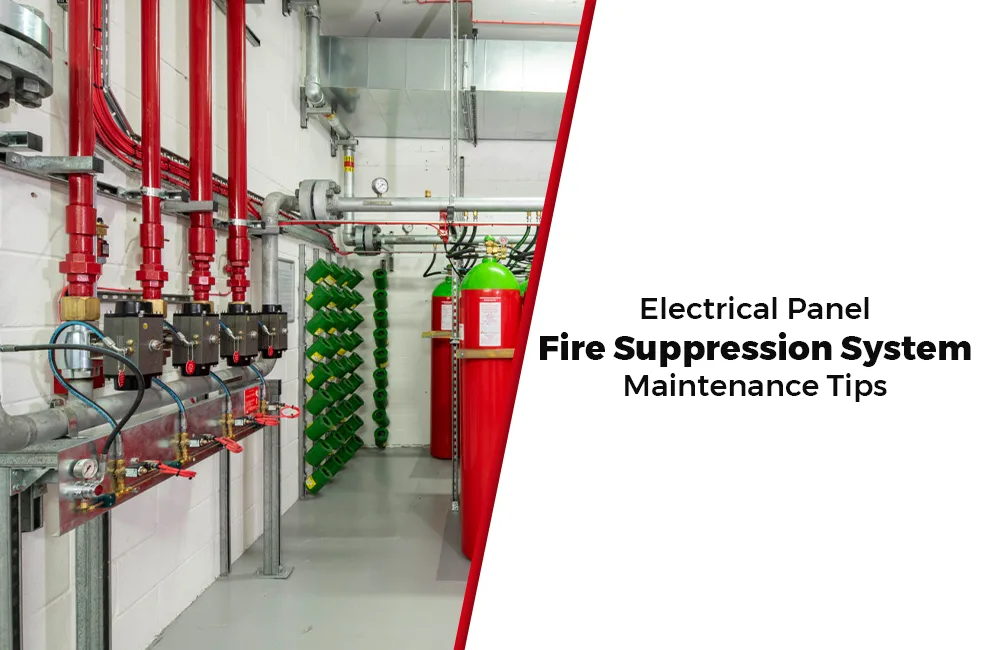Electrical panels play a crucial role in every building’s power distribution. But if neglected, they can be one of the highest fire risks. Unless you have a fire system in place, a small spark can result in a dangerous electrical fire.
They prevent or reduce damage, save lives, and promote the efficient operation of businesses. These systems alert people to fires early and suppress them before they become dangerous.
Electrical panel fire suppression system maintenance is essential to avoiding electrical fires and system malfunctions. By taking care of these problems through periodic inspections and maintenance, facilities can reduce the likelihood of potential risks.
The blog is intended to offer useful tips for maintenance of electrical panel fire suppression system.
Understand your fire suppression system
Let’s begin with the types of fire suppression systems. The primary categories are:
Clean agent systems: They employ gases such as FM-200 or Novec 1230 for fire extinguishing.
CO₂ systems: These systems suppress fire by displacing oxygen. They are effective in unoccupied areas like electrical rooms.
Dry chemical systems: They employ powder-based chemicals such as monoammonium phosphate. These are useful in industrial environments.
Now let’s move on to the components of a fire suppression system. The main components are detection devices, control panels, actuation mechanisms, nozzles and pipes, alarm and notification devices and pressure & flow sensors.
Schedule regular inspections
Having a fire suppression system does not necessarily keep you safe. You need to inspect them from time to time to make sure that they are in good condition. They should be inspected every six months or annually to confirm that they function normally and are safe. The National Fire Protection Association (NFPA) suggests inspections must be performed by a certified technician.
This inspection assures the state and functionality of all parts of the system like alarms, control panel, sensors etc.
While inspecting, make sure the fire suppression system is at its intended location and covers the area or equipment to be protected. Ensure manual actuators are readily accessible, unobstructed, and in full working condition.
Keep the area around the electrical panel clean
Remove combustible materials such as clutter, debris, and dust. These can cause fires to burn and block entry during emergencies. To avoid overheating caused by the lack of adequate airflow, ventilation is needed. Avoid allowing water to come into contact with the panel to stop short circuits and electric shock hazards.
Storing items near them may restrict access to the panel, delay emergency response, or become a source of fire if a fault occurs. Combustibles near electrical panels can catch fire quickly if there’s a spark or an overheated component.
Test alarm and detection components
Ensure that detection equipment such as smoke alarms, heat detectors, and flame detectors is operational. Check the indicators in the control unit and make sure all panel lights, displays, and fault indicators are correct. Alarm sounders and visual alerts are crucial in an emergency. Reassure that audible alarms and strobe lights will work during an emergency.
Test the backup batteries and ensure they are in working condition. Check the batteries and replace any weak, expired, or damaged. Don’t forget to log all test dates, results, and corrective actions in a maintenance record.
Check the suppression agent levels
For systems that use stored fire suppression agents, verify pressure gauges or measure cylinder weights to ensure agent levels are within an acceptable range. There are chances of leakage, so check for residue, corrosion, or an unexpected drop in pressure. If the levels are low, refill or replace the cylinder immediately. Follow manufacturer or system-specific guidelines for refilling or replacing the suppression agent. Document inspection findings and any corrective actions taken.
Keep maintenance records
Keeping records of maintenance helps with audits, compliance and tracking system performance. All inspections, tests, repairs and replacements must be logged including dates, findings, agent levels, parts changed, issues fixed, and service provider details etc.
These records help ensure compliance with fire safety regulations and insurance requirements. Additionally, maintaining a history of service activities helps to identify recurring issues, anticipate potential failures, and plan preventative maintenance more efficiently.
Train staff or occupants
Staff or occupant training is an essential part of electrical panel fire suppression system maintenance. All people in the building should know the workings of the fire suppression system and the response if it is triggered. This includes identifying alarm signals and evacuation routes. Periodic fire safety training and emergency drills ensure that individuals can respond well and quickly in the event of an actual occurrence.
Maintenance of electrical panel fire suppression system is critical to guarantee safety, operational integrity, and meet fire safety standards. A well-maintained system not only minimizes the possibility of failure but can avoid expensive fire damage and, above all, save lives. By staying ahead of routine inspections, testing, and employee training, you make the space safer for all.
Safetik is the leading fire fighting company in Kerala that offers the best fire and safety services. With more than 20 years’ experience, we have delivered many successful projects across various industries. Don’t wait for a fire accident to take place. Book your next maintenance visit with us today and stay protected.

